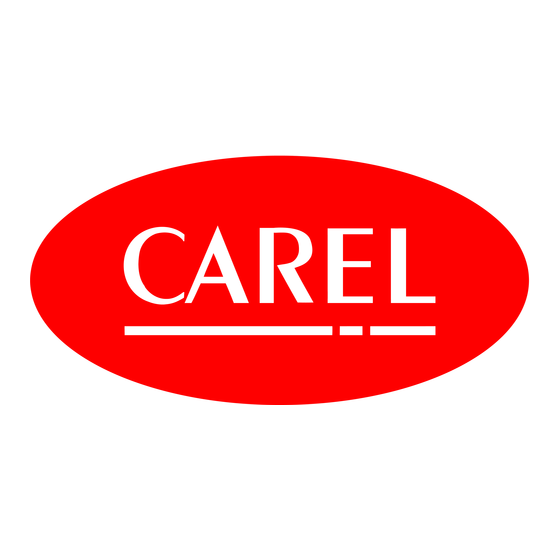
Table of Contents
Advertisement
Advertisement
Table of Contents

Summarization of Contents
Warnings and Disposal
Product Safety Warnings
Essential safety precautions for operating the EVD evolution driver to prevent hazards.
WEEE Disposal Guidelines
Instructions for the proper disposal of Waste Electrical and Electronic Equipment.
Introduction to EVD Evolution
EVD Evolution Models
Overview of available EVD evolution driver models, including their features and configurations.
Key Functions and Characteristics
Summary of the EVD evolution driver's primary functions, capabilities, and connectivity options.
Installation Guide
Physical Installation and Terminals
Guidance on DIN rail mounting, dimensions, and description of driver terminals.
Wiring and Connection Diagrams
Electrical wiring diagrams for superheat control and general connections.
Installation Guide
Installation and Connection Procedures
Step-by-step instructions for connecting probes, inputs, and power supply.
Valve Operation Modes
How to configure CAREL valves for parallel or complementary operation.
Installation Guide
Converter and Parameter Management
Connecting converters and managing parameters via the display interface.
User Interface
Display Board and Keypad
Instructions for display board assembly and overview of keypad functions.
Display Operation and Modes
Understanding the driver's display status, variables, and connection information.
User Interface
Display Modes Explanation
Navigating display modes to view system variables and electrical connections.
Programming Modes and Parameter Access
Accessing and modifying Service and Manufacturer parameters via the keypad.
Commissioning Procedures
Initial Commissioning Steps
Key parameters required for initial driver setup using different interfaces.
Guided Commissioning Procedure
Step-by-step process for configuring the driver via its display.
Commissioning Procedures
Post-Commissioning Checks and Functions
Verifying setup and selecting other control functions after commissioning.
Control Functions
Main and Auxiliary Control Types
Differentiating between main control modes and auxiliary control functions.
Superheat Control Mechanism
How superheat control optimizes evaporation and prevents liquid return.
Control Functions
Adaptive Control and Autotuning
Automatic PID parameter optimization for variable thermal loads.
Control Functions
Digital Scroll Compressor Control
Specific control strategy for Emerson Digital Scroll compressors.
Control Functions
SIAM ANB Scroll Compressor Control
Control for SIAM ANB compressors using CAREL Power+ speed drives.
Superheat Regulation with Two Probes
Using two temperature probes for superheat regulation, noting precision.
Control Functions
Advanced Regulation Modes
Detailed explanation of advanced controls like EPR and hot gas bypass.
Control Functions
Hot Gas Bypass by Temperature
Modulating valve based on ambient temperature for cooling capacity control.
Transcritical CO2 Gas Cooler Control
Managing pressure and efficiency in transcritical CO2 systems with gas coolers.
Control Functions
Analogue Positioner Control
Valve control via 4-20mA or 0-10V input signals, without PID.
I/O Expander for PCO
Using the driver as an actuator for pCO controllers via LAN.
Control Functions
Auxiliary Control Functions
HITCond protection, modulating thermostat, and backup probe features.
Functions Overview
Power Supply and Network Settings
Configuring power supply modes and network communication parameters.
Inputs and Outputs Configuration
Setting up analogue probes and digital inputs for driver operation.
Functions Overview
Understanding Control Status
States indicating driver operation: standby, wait, control, and positioning.
Functions Overview
Advanced Control Statuses
Special driver statuses for manual positioning, valve recovery, and unblocking.
Protectors and Safety Features
Protector Overview
Introduction to the four main protectors: LowSH, LOP, MOP, High Tcond.
Protectors and Safety Features
LowSH Protection Details
Configuration and operation of the low superheat protection function.
Protectors and Safety Features
LOP Protection Details
Functionality and settings for the low evaporation pressure protection.
MOP Protection Details
Operation of the high evaporation pressure protector for compressor safety.
Protectors and Safety Features
High Tcond Protection Details
High condensing temperature protection mechanism and its settings.
Parameters Table
Unit of Measure Configuration
Setting measurement units (°C/K/barg or °F/psig) and their impact on parameters.
Parameters Table
Serial Communication Variables
List of variables accessible via serial connection, including addresses and types.
Variable Usage by Control Type
Mapping of variables based on the selected main and auxiliary control types.
Alarms and Error Handling
Alarm Overview and Signaling
Types of alarms, their causes, and how they are signaled on the device.
Alarms and Error Handling
Relay Configuration and Probe Alarms
Relay configuration for alarms and details on probe-related alarms.
Alarms and Error Handling
Control Alarms and Motor Errors
Alarms related to protectors, EEV motor faults, and control issues.
Alarms and Error Handling
LAN Error Alarm and System Issues
Troubleshooting LAN connectivity and other system-related alarms.
VPM Appendix: Software Configuration
VPM Software Installation and Setup
Guide to downloading and installing the Visual Parameter Manager software.
Using VPM for Device Programming
Steps for creating projects, configuring devices, and managing parameters in VPM.
VPM Appendix: Software Configuration
Parameter and Firmware Management
Copying setups, setting defaults, and updating driver/display firmware.


Need help?
Do you have a question about the EVD0000E41 and is the answer not in the manual?
Questions and answers